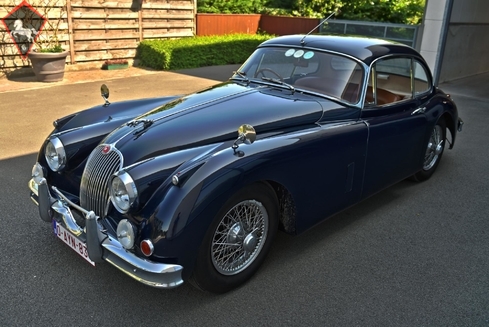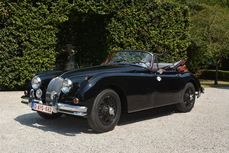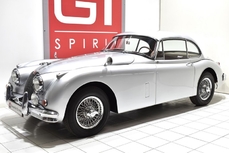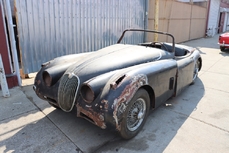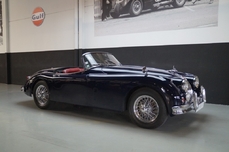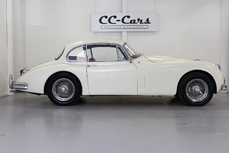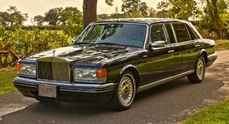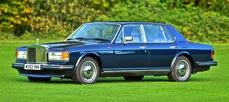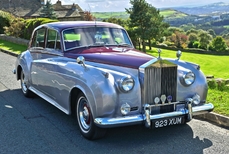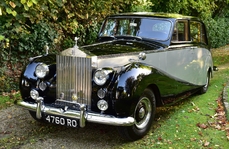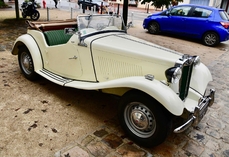Jaguar XK150 Right Hand Drive, Fixed Head Coupe 1957
General description :
1957 Jaguar XK150 RHD FHC.
Chassis number: S824016
Registration number: 0AYN834 (Belgium).
A very very early Jaguar XK150 FHC. Indeed this is the earliest known RHD FHC XK150 known being the 16th unit to come down the production line at Browns Lane. When new it was sent straight to the rust free balmy climes of South Africa & also spent time in Botswana according to the token of insurance decal in the windscreen.
The car is finished in lightly patinated dark blue paint. It is not concours perfect but is very presentable making it a very useable car. To the interior is lovely tan Leather throughout in wonderful condition. The story goes on under the bonnet where we find the lusty 3.4 litre twin cam in robust health starting readily & pulling strongly. The engine drives through a standard Moss gear box as would be expected.
The car was imported to Belgium from South Africa & has formed part of a small collection of cars which is now being disbanded. I have to stress how utterly rot free & solid this car is. Looking at its underside whilst on a ramp I was pleasantly surprised at its wonderfully preserved overall condition.
The car sits on four knock off wire wheels shod with nearly new tyres.. A leaper Jaguar mascot is affixed to the bonnet. I have to stress how straight honest & useable this Jaguar is. It has just been serviced so is absolutly ready to go. Viewings are near Ghent in Belgium, but will come to us once we have disposed of some of the other cars in the collection. It is the kind of car that puts a smile upon your face the moment you set foot in it.
http://www.vintagerollsroycecars.com/sales/1753/1957-jaguar-xk150-rhd-fhc/
1957 Jaguar XK150 Right Hand Drive, Fixed Head Coupe is listed sold on ClassicDigest in Grays by Vintage Prestige for Not priced.
Car Facts
Car type : Car Make : Jaguar Model : XK150 Model Version : Right Hand Drive, Fixed Head Coupe Engine size : 0.0 Model Year : 1957 Sub type : Van Location : Essex
Sold
Seller Information
Sold
People who viewed this Jaguar XK150 also viewed similar Jaguar listed at ClassicDigest
Other cars listed for sale by this dealer
About Jaguar
Ah, the story of Jaguar, from its early days as the SS Cars Ltd. to its pinnacle with the D-type, and the street-going evolution in the form of the iconic E-type. There's something quintessentially British about this tale, and I'll narrate it as a British journalist might.In the Beginnings:
Our journey into the world of Jaguar begins in the 1930s, when a company known as SS Cars Ltd. emerged. Despite the unfortunate coincidence of their initials with the rising political tensions in Europe, they started producing stylish and performance-oriented cars. The SS 100, introduced in 1936, was a symbol of elegance and speed, setting the stage for what would become Jaguar.
The Birth of Jaguar:
As the shadows of World War II loomed, SS Cars Ltd. wisely decided to disassociate themselves from the SS initials. Thus, in 1945, they officially became Jaguar Cars Ltd., a name that would soon be synonymous with British luxury and performance.
The XK Series:
Jaguar's post-war era brought us the XK 120, a true sensation in 1948. With its sleek design and a powerful 3.4-liter inline-six engine, it became the world's fastest production car. The XK 120 was the blueprint for what lay ahead – Jaguars that blended style with speed in a uniquely British fashion.
The D-type Dominance:
Then came the D-type, a true racing legend. Introduced in 1954, it won Le Mans three times in the 1950s, showcasing Jaguar's engineering prowess. With its innovative monocoque construction and the iconic fin at the back, the D-type was the apex of Jaguar's motorsport success.
The E-type Emergence:
But the true turning point arrived in 1961 with the introduction of the E-type, often described by Enzo Ferrari as "the most beautiful car ever made." Its long bonnet, curvaceous body, and a 3.8-liter engine delivering exhilarating performance made it an instant classic. The E-type was not just a car; it was a work of art on wheels, and it could hit 150 mph on the road.
Street and Racing Success:
The E-type's beauty was matched by its capability on the track. The lightweight E-types were particularly successful in various racing events, cementing Jaguar's reputation as a force to be reckoned with in motorsport.
The Age of Refinement:
As we delve deeper into the Jaguar story, we find that the 1950s and 1960s were an age of refinement and expansion. Alongside the magnificent D-type and the E-type's iconic emergence, Jaguar introduced models that further solidified its reputation for luxury and performance.
The MK2:
In the late 1950s, Jaguar unveiled the MK2, a sports sedan that combined elegance with power. This sleek four-door saloon was a favorite of bank robbers and law enforcement alike, thanks to its exceptional speed and handling. The MK2 was a symbol of Jaguar's ability to blend sophistication with performance and had a successful racing career as well.
The XJ6:
Fast forward to 1968, and Jaguar launched a car that would define luxury saloons for decades to come – the XJ6. It was a masterpiece of engineering and design, featuring a smooth inline-six engine, independent rear suspension, and a spacious, beautifully appointed interior. The XJ6 was a symbol of British elegance and provided a ride so smooth that it seemed to glide over the road. It became the flagship model for Jaguar and set the standard for luxury saloons, showcasing a level of refinement that left competitors in awe.
The Blend of Classic and Modern:
While the MK2 and XJ6 represented the evolution of Jaguar's saloon cars, they maintained the brand's commitment to performance and luxury. These cars didn't just belong on the racetrack; they were equally at home cruising down the grand boulevards or gliding through the English countryside.
The Challenges of Change:
However, as the 1970s arrived, Jaguar, like many British automakers, faced financial challenges and changes in ownership. The British Leyland era brought both opportunities and struggles, as the brand navigated through various mergers and transitions.
Nevertheless, the legacy of the MK2 and XJ6, along with the D-type and E-type, continues to define Jaguar as a manufacturer that combines timeless elegance with a spirit of performance. These classic models, whether driven on winding roads or parked as collectors' treasures, serve as a testament to Jaguar's enduring presence in the world of automotive excellence.
The Jaguar story, from its early days as SS Cars Ltd. to the creation of automotive icons like the E-type, MK2, and XJ6, is a journey that reflects the very essence of British motoring – a blend of luxury, power, and style that continues to captivate enthusiasts and connoisseurs alike.
